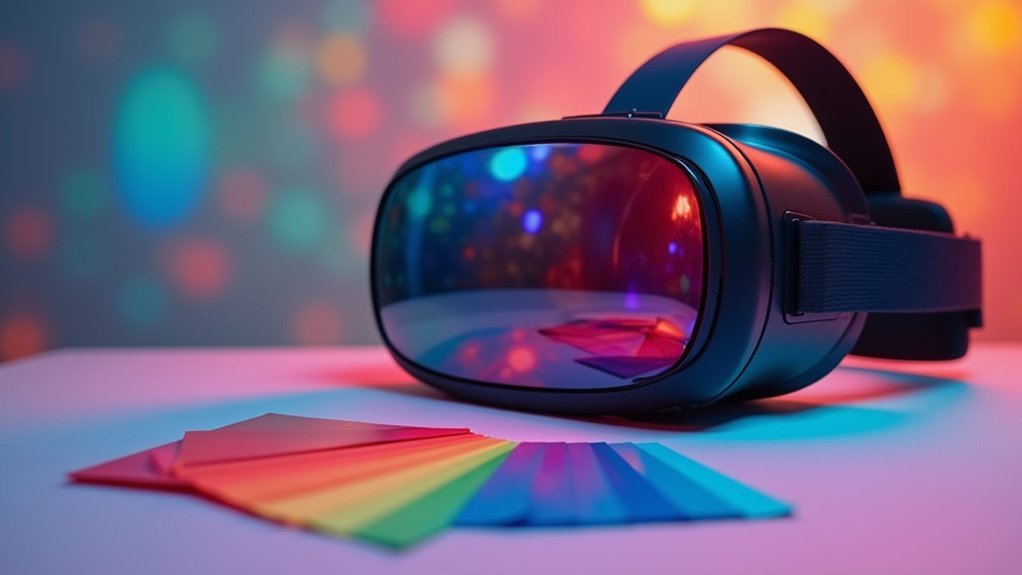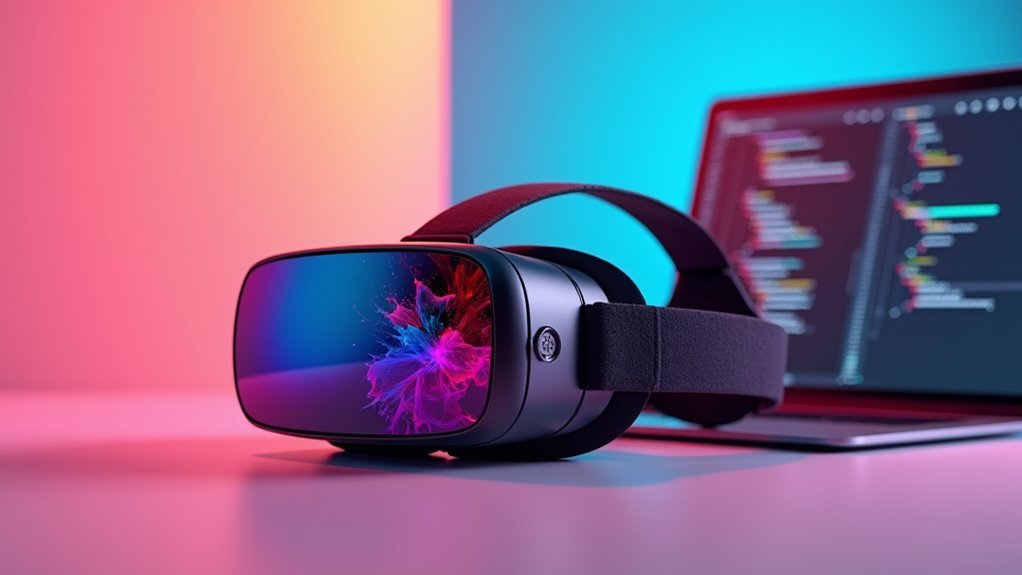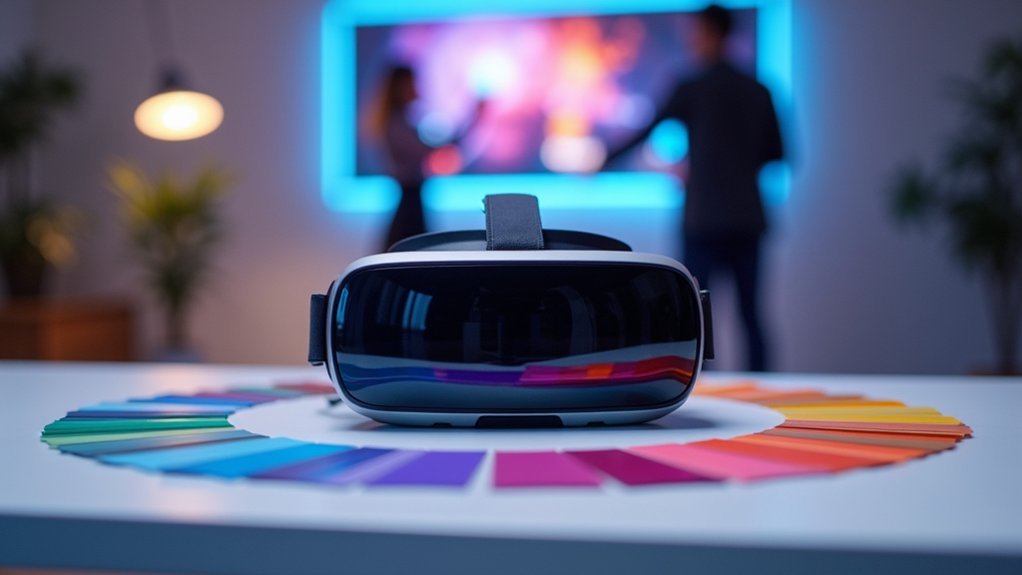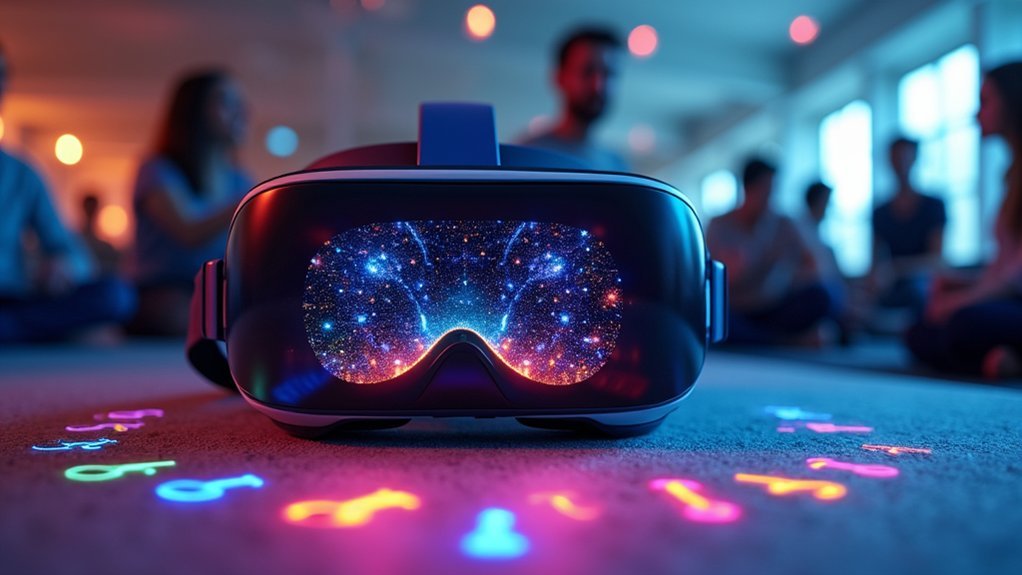You’ll find that modern VR headsets now include built-in accessibility features specifically designed for color vision deficiencies. These systems offer adjustable display settings like contrast, saturation, hue shifts, and color correction filters that accommodate deutan, protan, and tritan color blindness types. Developer frameworks like Meta’s VRC.Accessibility.5 enable customizable post-processing effects, while hardware adapters can mount colorblindness glasses onto headsets. Understanding these extensive solutions will transform your virtual reality experience into something truly inclusive.
Understanding Color Blindness Types and Their Impact on VR Experiences

When you enter a virtual reality environment, your perception of that digital world depends heavily on how your eyes process color information. If you have color blindness, you’ll experience VR applications differently than intended.
Deutan color blindness affects your ability to distinguish red and green shades, while Protan creates red vision deficiency challenges. Tritan impacts blue-yellow color perception, altering how you see virtual landscapes and interface elements.
These variations in color perception profoundly impact your VR experience. You might struggle with navigation systems that rely on color-coded waypoints, miss critical gameplay elements, or find yourself disadvantaged in puzzles requiring color differentiation.
Understanding your specific type of color blindness helps developers create more inclusive VR applications that accommodate diverse visual processing needs.
Current Accessibility Settings Available in VR Headsets
Modern VR headsets offer several built-in accessibility features designed to address color vision deficiencies.
Built-in accessibility features in modern VR headsets effectively address color vision deficiencies for more inclusive virtual experiences.
You’ll find extensive options in current devices like Meta Quest, which includes dedicated Accessibility tabs with specialized tools for users experiencing color blindness.
These VR headsets provide essential adjustments to enhance your visual experience:
- Color Correction – Modifies color output to compensate for specific types of color vision deficiencies
- Display Adjustments – Controls contrast, saturation, temperature, hue shift, and tint settings
- Height Adjustment – Accommodates different physical needs and viewing preferences
- UI Visibility Enhancement – Improves interface elements and object recognition
You can customize these accessibility features based on your individual requirements.
Research shows that when you adjust these color vision settings, you’ll experience improved engagement and comfort in virtual environments, making VR more inclusive.
Implementing Developer Tools for Color Vision Accommodation

While headset manufacturers provide baseline accessibility features, developers hold the key to creating truly inclusive VR experiences through specialized accommodation tools.
You can implement adjustable display settings like hue shifts and saturation adjustments to accommodate various color vision deficiencies. Unity’s post-processing effects enable you to create customizable color correction tools tailored to individual color blind users, helping them differentiate critical game elements.
Integrating VRC.Accessibility.5 provides user-adjustable settings for contrast, temperature, and tint, enhancing visibility for users with color vision impairments.
Tools like ReShade allow you to replace specific colors throughout your game, creating more inclusive environments. These developer tools guarantee your VR applications cater to diverse user bases while maintaining engaging gameplay for everyone.
GPU Color Adjustments and Post-Processing Filters for Enhanced Visibility
You can dramatically improve your VR color perception by adjusting your GPU’s saturation and hue settings to make previously indistinguishable colors more visible.
ReShade filters offer another powerful solution, letting you implement custom post-processing effects that enhance specific color ranges problematic for your type of color blindness.
These tools also enable complete color replacement, where you’ll swap out troublesome color combinations with alternatives that work better for your vision.
GPU Saturation Enhancement Methods
Three primary GPU enhancement methods can dramatically improve color visibility for users with color vision deficiencies in virtual reality environments.
These saturation enhancement techniques allow colorblind users to customize their visual experience through targeted gpu settings adjustments that make critical game elements more distinguishable.
- Saturation and vibrance controls – Increase color intensity through your GPU’s control panel to enhance overall color perception.
- Individual color channel adjustments – Fine-tune red, green, and blue levels separately to compensate for specific color vision deficiencies.
- Gamma correction modifications – Adjust brightness curves to improve contrast between problematic color combinations.
- Digital vibrance scaling – Apply selective color boosting to enhance specific hues that are typically difficult to distinguish.
You’ll need to experiment with different combinations since ideal settings vary between games and individual color vision needs.
ReShade Filter Implementation
Although built-in GPU controls provide basic color adjustments, ReShade offers far more sophisticated post-processing capabilities that can transform how colorblind users experience virtual reality games.
You’ll find ReShade’s customizable filters can target specific color values and replace them throughout your VR environment, providing accessibility solutions that standard settings can’t match.
You can manipulate saturation, contrast, and brightness to distinguish between colors that normally appear identical. This proves especially valuable in color-dependent puzzles and gameplay scenarios where colorblind accessibility becomes critical for enjoyment.
Implementing ReShade requires experimentation since ideal settings vary between games and individual needs. You’ll need to test different filter combinations through trial and error, but the results greatly improve color perception in virtual environments, making previously inaccessible content fully playable.
Custom Color Replacement
Several GPU color adjustment techniques can dramatically transform your VR experience by targeting specific problematic colors and replacing them with more distinguishishable alternatives.
Custom color replacement through post-processing filters allows you to modify color temperature and saturation levels based on your specific vision needs.
These techniques markedly improve the accessibility of VR by providing personalized visual adjustments:
- Hue shifting – Replace problematic red-green combinations with blue-yellow alternatives for better distinction
- Brightness enhancement – Amplify contrast between similar colors to improve visual separation
- Game-specific configurations – Create unique filter profiles for different VR applications and content types
- Real-time adjustments – Modify color settings instantly without restarting your VR session
You’ll find these custom color replacement methods particularly effective in color-dependent puzzles and navigation scenarios.
Hardware Solutions and Custom Lens Options for Color Blind Users
You’ll find that current VR lens replacement options focus primarily on vision correction rather than addressing color vision deficiencies, leaving a significant gap in hardware accessibility.
While some manufacturers are exploring integrated colorblind-friendly features, you’re still facing limited availability and questionable effectiveness in today’s market.
The challenge you encounter stems from the complex engineering required to incorporate color correction technology into compact VR lens systems without compromising visual quality or comfort.
Current VR Lens Limitations
When you’re searching for VR headsets with built-in color blindness solutions, you’ll quickly discover a significant gap in the market. Current manufacturers primarily focus on traditional vision correction, leaving people with disabilities like color blindness without dedicated hardware solutions.
The limitations you’ll encounter include:
- Standard lens focus – VR headsets only address near or far-sightedness correction.
- Lack of color-specific technology – No built-in filtering systems for color differentiation.
- Market oversight – Manufacturers haven’t prioritized color blindness accommodations.
- Limited customization options – Custom VR lenses for color enhancement aren’t commercially available.
This creates challenges when you’re trying to experience virtual environments effectively. The absence of specialized color correction in VR hardware means you’ll need alternative approaches to enhance your virtual reality experience.
Colorblind Hardware Integration Options
Although mainstream VR manufacturers haven’t developed dedicated colorblind solutions, several hardware integration options can improve your virtual reality experience.
You can explore adapter systems that mount colorblindness glasses directly onto your headset, though effectiveness varies with indoor lighting and screen displays. Custom prescription lens inserts remain primarily focused on vision correction rather than colorblindness accommodation, leaving a significant gap in specialized hardware solutions.
Your best current options involve external accessories that clip onto existing VR headsets. Some experimental approaches include modified lens filters designed specifically for virtual reality displays.
However, these hardware solutions often require manual adjustments and may not integrate seamlessly with all headset models. While dedicated colorblind hardware integration remains limited, ongoing accessibility improvements suggest future VR systems may incorporate built-in colorblindness support.
Custom Lens Development Challenges
Despite growing awareness of colorblind accessibility needs, custom lens development for VR headsets faces substantial technical and commercial obstacles.
You’ll find that most manufacturers haven’t prioritized thorough solutions for color vision deficiencies, leaving users with limited hardware options.
The key challenges preventing widespread custom lenses adoption include:
- Limited market availability – Custom lenses specifically designed for color differentiation in VR aren’t widely accessible.
- Variable effectiveness – Performance depends heavily on lighting conditions, with artificial indoor lighting reducing impact.
- Manufacturer priorities – Most companies focus on vision correction rather than color vision deficiencies.
- Research gaps – Insufficient collaboration between developers and scientists limits innovation validation.
You’ll need industry-wide commitment and scientific partnerships to overcome these barriers and create effective custom lenses for colorblind VR users.
Meta’s VRC.Accessibility.5 Framework for Inclusive VR Development
Since traditional VR experiences often overlook users with visual impairments, Meta developed the VRC.Accessibility.5 framework to bridge this gap through extensive display customization tools.
This framework specifically targets color blindness through user-adjustable display settings including contrast, saturation, temperature, hue shift, and tint modifications.
You can implement VRC.Accessibility.5 in your Unity projects using post-processing effects that’re compatible with the Universal Render Pipeline.
The framework allows users to customize saturation for achromatopsia and apply hue shifts to differentiate colors more effectively.
Future updates will include alternative controls, movable menus, and enhanced text options.
Meta’s commitment to inclusive VR development guarantees you’ll have robust accessibility tools for creating experiences that accommodate diverse visual needs.
Testing and Optimizing Color Blind Accessibility Features in Virtual Environments

When you’re developing color blind accessibility features for VR environments, testing becomes a complex process that requires multiple validation methods to guarantee your solutions work across different types of color vision deficiency.
You’ll need to implement iterative testing approaches since individual experiences vary considerably among users. Your development process should incorporate:
- Adjustable display settings with hue shift and saturation controls for Deutan and other color blindness types
- Custom post-processing filters using tools like ReShade to enhance visibility in VR games
- Simulator sickness monitoring as color vision deficiency can affect motion sensitivity in virtual environments
- Open-source collaboration with researchers to validate your accessibility solutions
Through systematic testing of these color blind accessibility features, you’ll create more inclusive virtual environments that accommodate diverse visual needs while minimizing discomfort.
Frequently Asked Questions
Can Blind People See in VR?
You can’t see traditional visuals in VR if you’re blind, but audio-based VR experiences and haptic feedback can provide immersive environments through sound, vibrations, and spatial audio cues instead.
What Are the Best Colors for Color Blind Accessibility?
You’ll find blues and yellows work best for most color blindness types. Use high contrast pairings like dark blue with bright yellow, or combine orange and pink for tritan users needing clear visual differentiation.
What Is Assistive Technology for Color Blindness?
You can use colorblindness glasses that filter specific light wavelengths, post-processing software filters like ReShade for gaming, and customizable display settings that adjust contrast, saturation, and hue for better color perception.
Are VR Headsets Accessible?
You’ll find VR headsets becoming more accessible with features like color correction settings and contrast adjustments. However, they’re still limited in extensive color remapping options for colorblind users.





Leave a Reply